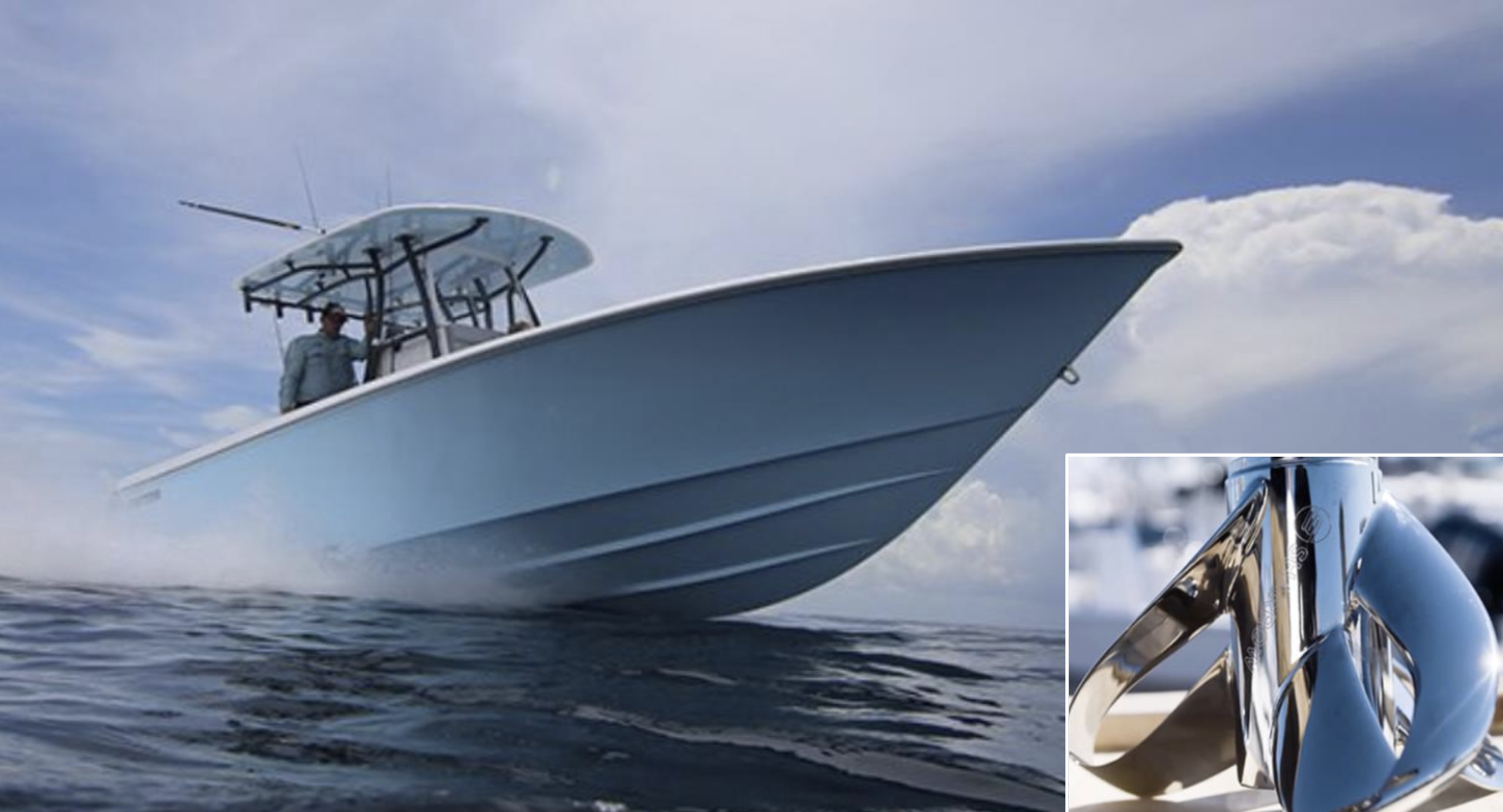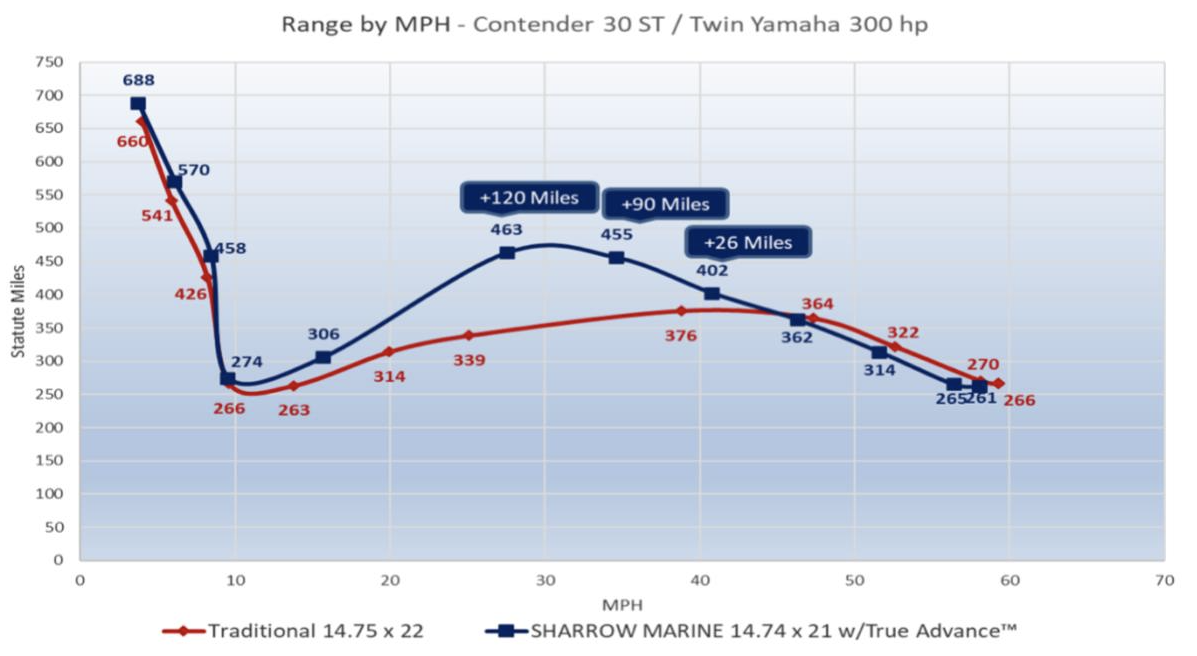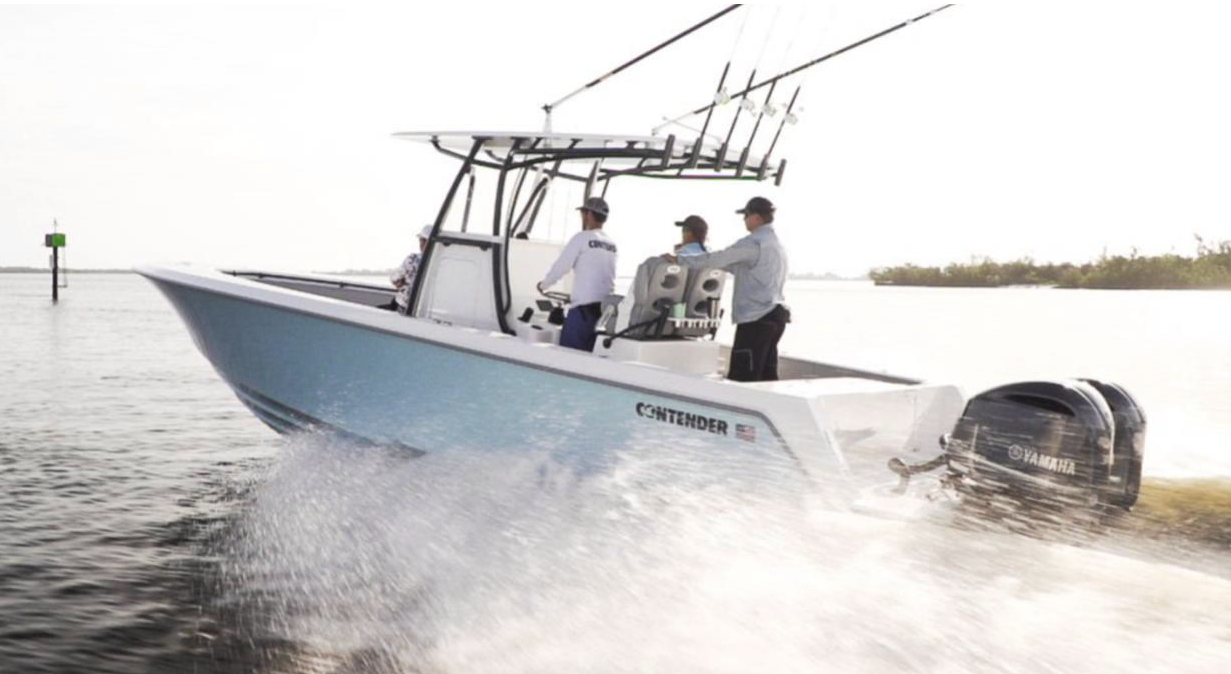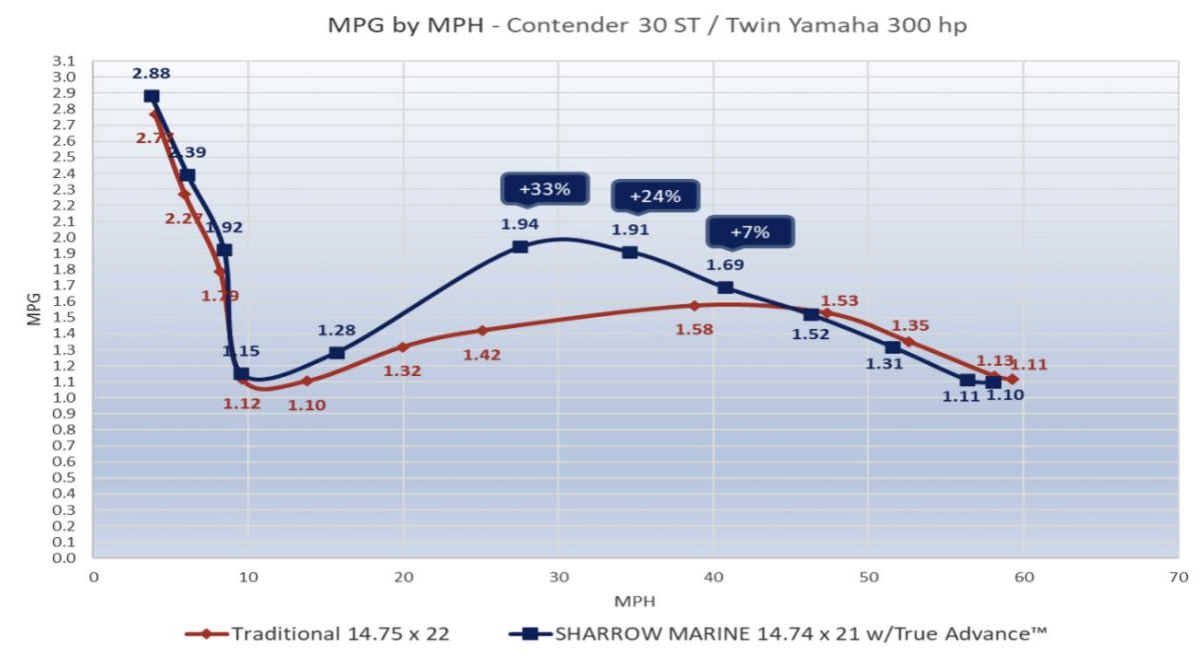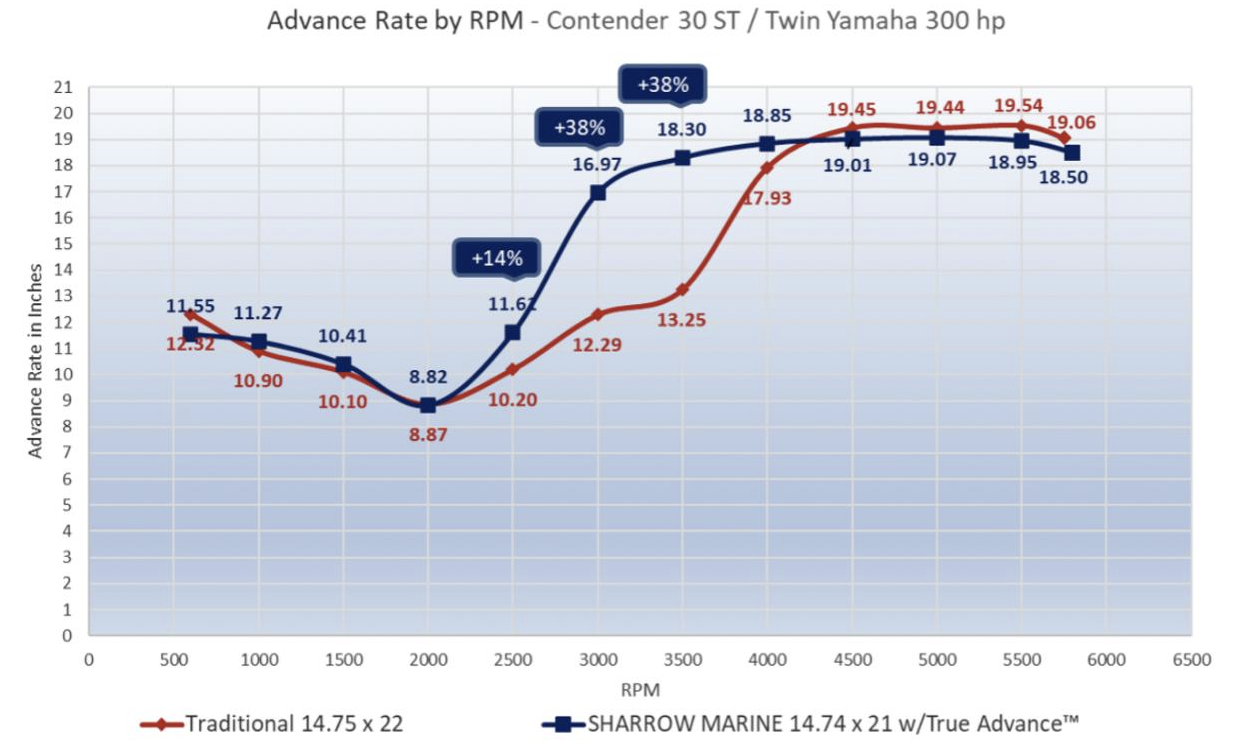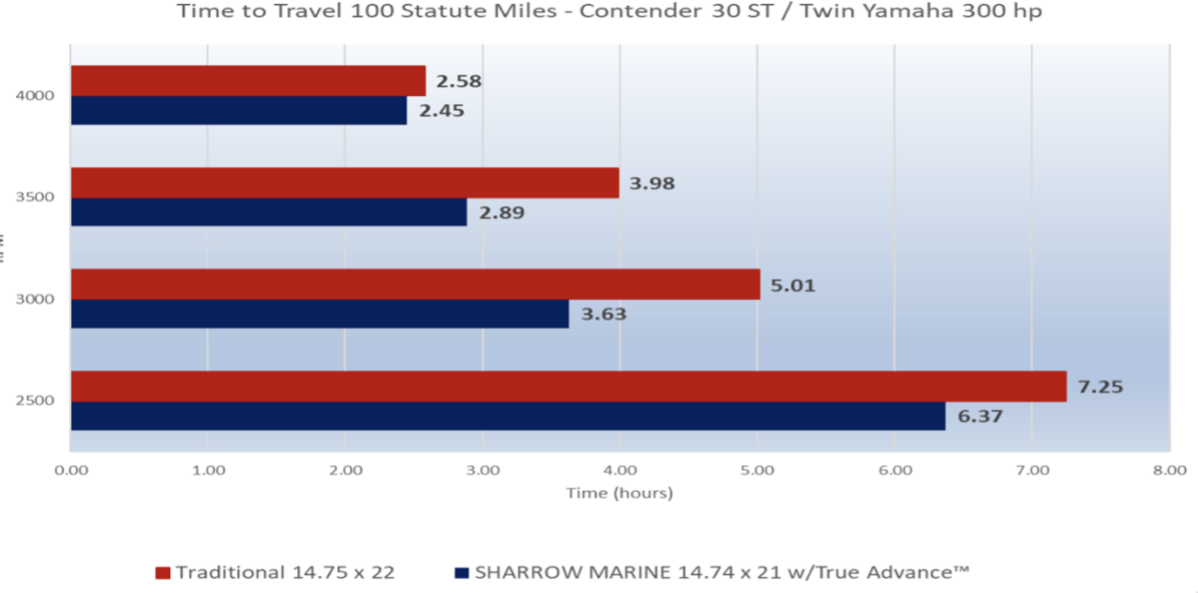Sharrow Props Make the Contender 30ST A Long Ranger – 118 Miles Longer
The Contender 30ST is famous for its fishability with large multi-livewells and big fish boxes. They’re designed for both meat anglers and big-game trophy-hunters who use them for canyon-running, as well as near-coastal fishing. It’s here that the Sharrow props come into their own because they are so much more fuel-efficient in the mid-range. See the results of a recent Sharrow comparison test pitting conventional wheels against its revolutionary loop props on a Contender 30ST.
Extended Range is Invaluable
Historically, there were only three ways to extend a boat’s range – 1) go slower, 2) install larger fuel tanks if possible at the time of build, 3) or carry jerry cans or fuel bladders on deck.
Most anglers and cruising boaters when they set out have both a destination and time frame in mind. If the time frame is for hours of sunlight, it is finite, so going slower is often not an option. We only know a few builders who will install a larger, or added fuel tank, and it will be very expensive because it disrupts production and calls for extra engineering.
Jerry cans typically hold five gallons of fuel and weigh 30 gallons. In order to extend a boat’s range 100 miles, if the boat is getting 1.5 miles per gallon – about 14 jerry cans will be needed. Obviously that would be a safety issue, even if room could be found for them.
The Contender 30ST has a fuel capacity of 265 gal. (980 L). Reserving 10% for safety leaves just 238.5 gal. (882 L) for getting to the destination and back before dark. So how far can it go at a reasonable speed to accomplish getting to the fishing grounds, or reaching a desired cruising destination? It all depends on the fuel burn at the necessary speed.
Comparison Test: Old vs New
The Sharrow tech crew tested a Contender 30ST powered by twin Yamaha 300-hp engines turning 14.75 x 22 conventional props last year, and then ran the same trial with a pair of 14.74 x 21 Sharrow props.
Not surprisingly -- we have all seen enough of these comparison tests by now that we know the patterns that usually emerge – large disparities in the mid-range where most people operate their boats were recorded.
It is in the midrange that the Sharrow props earn their keep with fuel savings. But, what we often don’t dwell on is the extended range that can be achieved with Sharrow props. In the case of the comparison test on the Contender 30ST, it was startling.
As can be seen in the chart above, the range of the 30ST based on the data collected on test day, indicates that the boat with the 14.75 x 22 traditional prop designs, could travel about 352 statute miles at 30 mph.
Going 30 mph with the Sharrow props, the Contender 30ST has a range of 470 miles at the apogee of the curve – allowing for a 10% fuel reserve. In other words, that’s how far the boat can theoretically go on 238.5 gallons of fuel with the 14.74 x 21 Sharrow props. That’s 118 miles -- or 33.5% -- greater range than with legacy props.
Faster and Longer Distance
But, what is the Contender’s range at 40 mph with the twin 300s and standard-issue props? Here we find a much-improved story – then, the boat has a range of about 377 statute miles, or 7% more than at 30 mph.
Comparing the boat’s max range of 470 miles at 30 mph with the Sharrow props, and the max range of boat with conventional props going 377 miles at 40 mph, we see that the increased range provided by the Sharrows is 93 statute miles, or 24.6% greater.
At 40 mph, the Contender goes 26 miles farther with Sharrow wheels than with the standard props on a tank of fuel with a 10% reserve.
Conditions and Common Sense Dictate Speed
Most people we know would rather travel at 40 mph if the sea is mill-pond smooth, or even with a mild chop. But with anything more, say 2-4’ confused waves, most sensible boat operators will want to slow down and save their spines and knees. What is the fun of getting beaten to death? Veteran boaters have nothing to prove.
That extra-long range provided by the Sharrow props means blue water anglers can go father and stay out longer, no matter what the sea conditions.
The chart above matches miles per gallon vs miles per hour, and the source for our data to predict range. In this case at 30 mph, the boat was getting about 1.5 miles per gallon with the standard props and 2.0 mpg with the Sharrow props, or 33% more miles per gallon. Note that above 46 mph, the Sharrow props are slightly less fuel-efficient in this application. For boat owners planning on spending most of their time at 50 mph, range wouldn’t be a reason to buy the new technology props.
However, depending on the boat owner, other attributes of the Sharrow props, such as its backing power, easier docking, recognizable quietness, trolling speed sound and efficiency and reduction of onboard vibration, might be attractive.
Re-Visiting the Mid RPM Performance Gap
The above chart has an unusually positive pattern for a boat with conventional props. The chart indicated she went 20 mph, planing speed at 3000. Typically, we don’t see a vessel with standard props breakout onto plane until about 3500 or even more. But, the Sharrow props went 7.6 mph faster at 3000 RPM and 9.6mph faster at 3500 RPM in these Sharrow tests. This 3000 RPM to 4000, and sometimes 4500, is the sweet spot for Sharrow props.
The Loop Prop is Hard to Beat
The increased performance of Sharrow props is because of its “loop” design, with 6 blades compared to 3 on a conventional prop. Even though the prop surface area of a Sharrow is about the same as for a traditional prop, by virtually eliminating the prop-tip vortices, thus drag is virtually eliminated, and by getting a far better grip on the water with their 6 loops, Sharrow props have a significantly better “advance rate.”
In the chart above, the actual inches of advance can be seen for each of the props. For example, at 3500 RPM, the 21” pitch Sharrow props are advancing 18.3” and the standard 22” pitch props are moving forward only 13.25.” In other words, the boat is actually moving forward 38% more with the Sharrow props with each 360-degree rotation of the prop at that RPM.
What’s an hour of your time worth? At 3500 RPM and 34.7 mph, over a 100-mile run, you save over an hour in this Contender with the Sharrow props. If you’re a lawyer, that hour can be worth real money.
